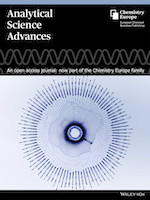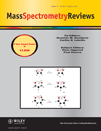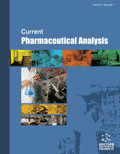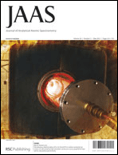
Analytical Science Advances
Scope & Guideline
Leading the Charge in Analytical Method Development
Introduction
Aims and Scopes
- Metabolomics and Lipidomics:
The journal emphasizes research in metabolomics and lipidomics, particularly in the context of health, disease diagnostics, and food safety. This includes both targeted and untargeted approaches to metabolite profiling. - Mass Spectrometry Techniques:
There is a strong focus on mass spectrometry applications, including advancements in quantitative mass spectrometry, ambient ionization techniques, and the development of new mass spectrometric methods for complex sample analysis. - Analytical Chemistry Innovations:
The journal highlights innovative analytical chemistry techniques such as chromatography, NMR spectroscopy, and Raman spectroscopy, exploring their applications in various fields including environmental science, pharmaceuticals, and food safety. - Nanotechnology in Analysis:
Research involving nanotechnology, especially the application of nanomaterials in sensors and analytical methods, is a core area of focus, showcasing the intersection of nanotechnology and analytical science. - Food and Environmental Safety:
A commitment to food safety and environmental monitoring is evident, with studies focused on contamination detection, biopolymer-based packaging, and the effects of environmental pollutants. - Emerging Analytical Technologies:
The journal is at the forefront of reporting on emerging analytical technologies, including machine learning applications in data analysis and the integration of artificial intelligence in analytical methods.
Trending and Emerging
- Bioactive Compounds and Natural Products:
There is a growing interest in the analysis of bioactive compounds derived from natural sources, such as plants and microorganisms, highlighting their potential applications in health and food safety. - Food Safety and Quality Control:
Emerging methodologies for ensuring food safety, including the use of microfluidics and intelligent packaging, indicate a significant trend towards enhancing food quality and safety through innovative analytical approaches. - Health-Related Metabolomics:
There is an increasing focus on metabolomics in the context of health applications, particularly in understanding disease mechanisms and developing diagnostic tools. - Environmental Analysis and Sustainability:
Research addressing environmental pollutants and sustainability practices is gaining importance, as scientists seek to develop methods for monitoring and mitigating environmental impacts. - Integration of AI and Machine Learning:
The application of artificial intelligence and machine learning in analytical methods is on the rise, reflecting a trend towards utilizing advanced computational techniques to enhance data analysis and interpretation. - Microbial and Biopolymer Applications:
There is a notable increase in research involving microbial applications and biopolymers for analytical purposes, indicating a shift towards sustainable and eco-friendly analytical solutions.
Declining or Waning
- Traditional Chromatographic Techniques:
There appears to be a decreasing emphasis on conventional chromatographic methods in favor of more innovative and efficient techniques. This shift indicates a move towards high-throughput and multi-dimensional approaches. - Basic Analytical Methodologies:
Studies focusing solely on basic or traditional analytical methodologies, without significant innovation or application, are becoming less frequent as the journal prioritizes cutting-edge research and applications. - In-depth Reviews on Historical Techniques:
There has been a noticeable decline in comprehensive reviews of older analytical techniques, suggesting that the journal is moving towards more contemporary and applicable research findings. - Generalized Toxicological Studies:
Research that addresses toxicological analyses in a generalized manner, without specific applications or innovative methodologies, is less prominent, indicating a preference for targeted, application-driven studies. - Single-Discipline Focus:
Papers that focus on a single discipline without interdisciplinary connections are decreasing, reflecting a trend towards more integrative approaches that combine multiple fields of study.
Similar Journals

JOURNAL OF ANALYTICAL CHEMISTRY
Exploring New Dimensions in Analytical MethodologiesJOURNAL OF ANALYTICAL CHEMISTRY, published by PLEIADES PUBLISHING INC, stands as a pivotal resource in the field of analytical chemistry, offering an innovative platform for researchers, professionals, and students to advance their knowledge and contribute to the discourse within the discipline. With an ISSN of 1061-9348 and an E-ISSN of 1608-3199, this journal features a focused exploration of analytical methodologies, instrumentation developments, and applications across various domains, contributing to practical and theoretical advancements in the field. Currently ranked in the Q3 category in Analytical Chemistry with a Scopus rank of #111 out of 156, it provides critical insights and innovation strategies for professionals aiming to enhance their analytical capabilities. Access to the journal is through standard subscription models, and it covers an extensive range of topics pertinent to the discipline from 1996 to 2024. Engage with the JOURNAL OF ANALYTICAL CHEMISTRY to be part of a vibrant research community dedicated to push the boundaries of analytical practices.

CHINESE JOURNAL OF ANALYTICAL CHEMISTRY
Connecting Minds in the World of Analytical ChemistryCHINESE JOURNAL OF ANALYTICAL CHEMISTRY, published by SCIENCE PRESS in China, stands as a prominent platform in the field of analytical chemistry since its inception in 1989. With its ISSN 0253-3820 and E-ISSN 1872-2040, the journal maintains a vital role in disseminating empirical research and innovative methodologies, contributing to the advancement of analytical techniques and their applications. The 2023 Scopus ranking positions the journal in the third quartile (Q3) within its category, reflecting a respectable standing among its peers. Researchers, professionals, and students alike engage with a broad range of topics, from instrumental analysis to environmental monitoring, each aiming to foster further scientific inquiry. Although it does not currently offer Open Access, the journal's rich repository of knowledge continues to be an essential resource for those in the analytical chemistry community, with an enduring commitment to scientific excellence and collaboration.

RAPID COMMUNICATIONS IN MASS SPECTROMETRY
Exploring the evolving landscape of mass spectrometry.RAPID COMMUNICATIONS IN MASS SPECTROMETRY is a leading journal published by Wiley, focusing on the rapidly evolving field of mass spectrometry and its applications across various domains, including analytical, organic, and spectroscopy chemistry. With its ISSN 0951-4198 and an E-ISSN of 1097-0231, the journal has firmly established itself as a reputable source of innovative research since its inception in 1987, and is set to continue until 2024. As evidenced by its 2023 Scopus rankings, the journal occupies a solid position in the realms of analytical chemistry (Q3), organic chemistry (Q3), and spectroscopy (Q3), reflecting its impact among a diverse audience of researchers and professionals. Although it is not an open-access publication, the findings shared within its pages are pivotal for advancing knowledge and practical applications in mass spectrometry, making it an essential resource for students and experts aiming to stay abreast of the latest scientific developments.

MASS SPECTROMETRY REVIEWS
Transforming Knowledge in Mass SpectrometryMASS SPECTROMETRY REVIEWS, published by Wiley, is a premier academic journal dedicated to advancing the field of mass spectrometry and its applications across a multitude of scientific disciplines. With an ISSN of 0277-7037 and an E-ISSN of 1098-2787, the journal has established itself as a vital resource within the realms of Analytical Chemistry, Biochemistry, Genetics, Condensed Matter Physics, and Spectroscopy, achieving Q1 status across these categories in 2023. As a testament to its significant contribution to scholarly research, it boasts impressive Scopus rankings, including a rank of #2 out of 76 in Chemistry - Spectroscopy and #4 out of 156 in Chemistry - Analytical Chemistry, placing it in the 97th percentile and above. Emphasizing high-quality, peer-reviewed research, MASS SPECTROMETRY REVIEWS serves as an essential platform for researchers, professionals, and students aiming to stay abreast of cutting-edge developments and methodologies in mass spectrometry. The journal is committed to fostering a deeper understanding of mass spectrometric techniques while also contributing to interdisciplinary advancements, making it a valuable addition to any academic library. Authors seeking to disseminate their work in a journal with a strong reputation and impact in the scientific community will find MASS SPECTROMETRY REVIEWS an ideal venue.

Brazilian Journal of Analytical Chemistry
Fostering Innovation in Analytical Chemistry ResearchBrazilian Journal of Analytical Chemistry, published by VISAO FOKKA COMMUNICATION AGENCY, serves as a vital platform for those engaged in the field of analytical chemistry, especially within the Latin American context. With an ISSN of 2179-3425 and an E-ISSN of 2179-3433, this journal aims to promote high-quality research and advancements in analytical methodologies, instrumentation, and applications spanning from 2010 to the present. Although it currently holds a Q4 rank in Analytical Chemistry by Scopus and is placed at the 24th percentile, its commitment to open access publishing provides invaluable opportunities for widespread dissemination of knowledge, catering to researchers, professionals, and students alike. The journal's editorial board comprises emerging and established experts aiming to bridge gaps in analytical chemistry research, particularly in a Brazilian and broader South American context. Situated in São Paulo, Brazil, the journal's role in fostering innovation and collaboration in analytical techniques makes it an essential resource for the academic community.

ANALYTICAL AND BIOANALYTICAL CHEMISTRY
Connecting Researchers with Cutting-Edge DiscoveriesANALYTICAL AND BIOANALYTICAL CHEMISTRY, published by SPRINGER HEIDELBERG, is a leading international journal that serves as a vital platform for innovative research in the fields of analytical and bioanalytical chemistry. With an impressive impact factor and ranking in the Q2 category for both Analytical Chemistry and Biochemistry, the journal highlights key advancements and methodologies that drive the discipline forward. Established in 1996 and continuing vigorously into 2024, it has gained significant recognition with Scopus rankings placing it in the 83rd and 78th percentiles within its categories, underscoring its impact and relevance. The journal's commitment to open access facilitates widespread dissemination of critical scientific knowledge, making it an essential resource for researchers, professionals, and students dedicated to exploring the complexities of chemical analysis. With its base in Heidelberg, Germany, ANALYTICAL AND BIOANALYTICAL CHEMISTRY continues to inspire and influence the global research community.

Current Pharmaceutical Analysis
Empowering Researchers with Cutting-Edge InsightsCurrent Pharmaceutical Analysis, published by Bentham Science Publishers Ltd, is a vital resource for professionals and researchers in the fields of Pharmaceutical Science, Biochemistry, and Molecular Medicine. Established in 2006, this peer-reviewed journal aims to provide a platform for the latest advancements and analytical methodologies in pharmaceutical research and drug development. Over the years, it has garnered attention for its rigorous scrutiny and contributions to the landscape of pharmacology, evidenced by its quartile placements in various categories, most notably Q3 in Pharmaceutical Science. Despite its current rankings placing it in the lower quartile in several disciplines, the journal remains an essential venue for both emerging and established researchers seeking to disseminate their findings. With the widespread accessibility of its articles, researchers, professionals, and students can engage with cutting-edge studies to foster innovation in pharmaceutical analysis. For access to the latest research contributions, readers can explore the digital archive and stay updated on pivotal discussions shaping the future of the pharmaceutical sciences.

JOURNAL OF ANALYTICAL ATOMIC SPECTROMETRY
Shaping the Future of Quantitative and Qualitative Analysis.JOURNAL OF ANALYTICAL ATOMIC SPECTROMETRY, published by the esteemed Royal Society of Chemistry, stands as a vital resource in the fields of Analytical Chemistry and Spectroscopy. Since its inception in 1971, this journal has been committed to disseminating cutting-edge research, offering an invaluable platform for the presentation of quantitative and qualitative analytical methods. With an impressive impact factor and a current classification in the Q2 category of both Analytical Chemistry and Spectroscopy, it significantly contributes to the advancement of knowledge in these disciplines. Researchers, professionals, and students looking to deepen their understanding of atomic spectrometry will find a wealth of innovative studies, reviews, and methodological papers that consistently push the boundaries of traditional and emerging analytical techniques. Although not an open-access journal, it provides accessible options that facilitate the engagement of a broad academic audience, ensuring that vital research is not confined solely to institutional repositories. The journal's exceptional standing, demonstrated by its strong Scopus rankings, further underscores its critical role in the scholarly communication landscape.

Analytical and Bioanalytical Chemistry Research
Exploring Innovations in Chemical Analysis.Analytical and Bioanalytical Chemistry Research is an esteemed open-access journal published by the Iranian Chemical Society, dedicated to the advancement of knowledge in the fields of analytical chemistry, biochemistry, and spectroscopy. Since its inception in 2014, this journal has provided a platform for researchers, professionals, and students to publish and access high-quality research articles that contribute to the understanding of chemical analysis and bioanalytical methods. With an ISSN of 2383-093X and an open-access model that promotes global dissemination of findings, it ensures that innovative research reaches a broad audience. The journal has consolidated its presence in the scientific community, currently ranked in quartile Q4 for analytical chemistry, biochemistry, and spectroscopy as of 2023. Its Scopus rankings, including a percentile of 34th in Analytical Chemistry, reflect its commitment to quality research and scholarly contribution. Situated in Tehran, Iran, the journal serves as a vital resource for academic discourse, offering insights into emerging trends and methodologies in analytical and bioanalytical chemistry.

Journal of Analysis and Testing
Pioneering research in environmental chemistry.Journal of Analysis and Testing is a premier academic journal published by SPRINGER SINGAPORE PTE LTD, dedicated to advancing the fields of analytical and environmental chemistry. With ISSN 2096-241X and E-ISSN 2509-4696, the journal has established a significant presence since its inception in 2017, converging its focus until 2024. The journal's outstanding rankings in 2023, including Q1 quartile placements in Analytical Chemistry, Instrumentation, and Spectroscopy, underscore its pivotal role in disseminating high-quality research. Researchers can access cutting-edge studies that explore innovative testing methodologies, electrochemical analyses, and material evaluations, making it an essential resource for professionals and students alike. The Journal of Analysis and Testing not only celebrates advances in science and technology but also promotes interdisciplinary collaborations, ensuring widespread impact across analytical and environmental domains. As such, this journal plays a vital role in shaping the future of analytical practices and methodologies, positioning itself as a key conduit for knowledge exchange in the scholarly community.